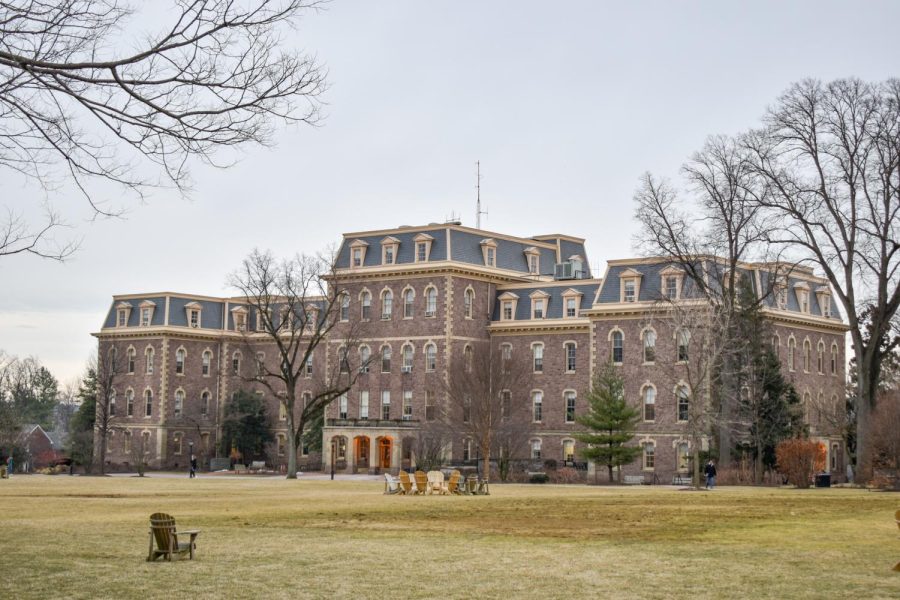Faculty committees to restructure, strengthen shared governance
If voted through this semester, changes to faculty committees are intended to go into effect in the fall of 2023. (Photo by Emma Sylvester ’25 for The Lafayette)
March 25, 2022
Later this spring, the faculty will vote on a new policy from the Faculty Governance Committee. This could restructure the current committees on campus. Although this policy has not been fully solidified, its goal is to eliminate certain committees in order to promote shared governance and allow faculty members to have an efficient impact on their fields of involvement.
Shared governance is the model by which Lafayette delegates governing responsibilities to the Board of Trustees, student representatives and the faculty.
Brett Hendrickson, chair of the Faculty Governance Committee, said that the committee has a responsibility to revisit the governance structure every three to five years, hence the recent reexamination of the framework. If faculty members vote it through this semester, it is intended to go into effect in the fall of 2023 to give a year-long preparatory transition period.
“Like many institutions of higher education, we embrace what we call shared governance, which is that all of the major constituencies have a voice in the operation of the institution,” Jennifer Talarico, the previous governance committee chair said.
The last time that the structure was revised was in the spring of 2014, during Talarico’s tenure. She explained that prior revisions did not eliminate any committees, but rather merged existing ones and changed the charge of others. For example, there used to be a committee that solely focused on athletics, which was brought under the umbrella of student life in 2014.
In terms of current plans, Talarico believes that the new policy will help Lafayette continue to embrace shared governance.
“I think that in order for shared governance to be effective, the voices of all of those parties need to be heard, and they need to be heard in a timely fashion,” Talarico said. “I think that our current structure does not always facilitate that process as effectively as it could.”
Hendrickson gave his reasoning for the policy.
“We’ve been exploring ways to reduce the number of committees to…focus our efforts where we’re doing the most, where faculty’s role in shared governance is the most pronounced, the tasks that we’re really responsible for,” he said.
The decision to create this policy was in part informed by the two non-faculty committees recently created by President Nicole Hurd which focus on budget and diversity. In creating these other committees, Hurd hoped to use a community-wide approach to take some pressure off of the faculty committees and perhaps replace them. The committees will be composed of four faculty members, four staff members and one student to bring in more community members than is the case under the current structure.
“If this goes well, I would think we will be making decisions with many more voices than we have right now,” Hurd said.
Achieving tenure at Lafayette is contingent on three different criteria–teaching, research, and service to the community. While not every faculty member serves on a committee, that is one avenue to fulfill the service requirement. Given that there are currently more faculty members than committee positions, Hendrickson emphasized that it is not a requirement to gain tenure.
“If there were any assumptions out there yet that you had to serve on a committee to get tenure, we want to…clarify that that won’t be the case,” Hendrickson said.
Of the 14 faculty committees on campus for this academic year, seven currently have students serving on them, all members of Student Government. Hendrickson acknowledged that the new policy would lower the number of students serving on committees simply by way of having fewer committees. However, he said that working with students is still an important focus.
“I don’t think that the disappearance of the committee is going to mean that faculty and students still won’t be collaborating on student conduct issues,” Hendrickson said. “I think that’ll just be going on under a different hospice instead of under like a faculty committee.”
While the number of students serving may be decreasing, Lia Charles, Vice President of Student Government, sees a possibility for student involvement if it is made a priority.
“It poses an opportunity for the faculty committees if they want to get more student engagement,” Charles said. “Like they’ll just have to think and be more creative about how to get that.”
Under this new policy, the standing faculty committee on Student Conduct would be eliminated, though faculty would still be involved in matters of student conduct. Hendrickson explained that Dean Jennifer Dize, Lafayette’s Assistant Dean of Students, serves as an administrative advisor on the faculty committee currently and would assume more control in the area once the committee was eliminated.
“As the college’s evolved, there are more opportunities for academic professionals to fill those roles,” Hendrickson said. “There’s less of a need for faculty, not necessarily to participate, but less of a need for faculty to lead those efforts.”
Dean Jennifer Dize declined to comment.
Correction 3/25/2022: This article previously stated that the restructuring of faculty committees would give students more voice in budgets. It is the new budget committee being created by President Hurd which will see more student involvement; the faculty budget committee is being eliminated.


























































































































